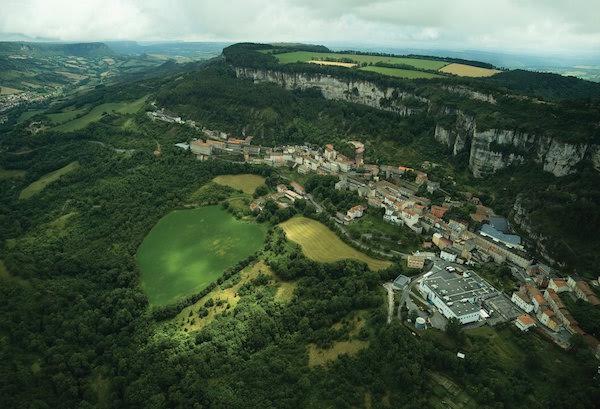Roquefort cheese could be bundled with any other blue cheese as its moldy appearance and strong smell is certainly a giveaway, but Roquefort isn’t just any French blue cheese. According to legend, a young shepherd, perched on the Combalou plateau, spied a beautiful shepherdess in the distance and determined to woo her, he hastily left his flock, but not before placing his meal of ewe’s milk curds on rye bread in a nearby cave. After days of hopeless searching, the shepherd returned, dejected and famished, to his leftover lunch which hardly looked like the appealing meal he had abandoned. Mold had blanketed the bread and deep green veins marbled the curds but the starving shepherd took a bite of the moldy cheese anyways and cried out “Mais c’est bon,” meaning it’s OK, and thus Roquefort was born.
Roquefort Cheeses’ history starts all the way back when southern France’s landscape was shaped by earthquakes that created the beautiful mountain ranges as well as some very special caves in the modern-day Mont Combalou. What’s more, in addition to forming caves, the collapsing rock also formed fleurines, or little faults, in the rock which hold the magic to the longevity of the process as they channel outside air through the caves keeping the temperature cool, between 46 and 53ºF, as well as maintaining a constant high humidity of 98%, meaning the conditions are perfect for the cheese’s production.
I’ve learned that these caves have produced Roquefort cheese for centuries and only the cheese that has been naturally aged here can be called “Roquefort”. In fact, in 1411 King Charles VI of France made sellers of counterfeit Roquefort cheese liable for punishment. Then in 1996, it was given the European designation of PDO or Protected Designation of Origin, meaning no one else can make a cheese called Roquefort anywhere else other than in this area under regulated conditions and thus ensuring that wherever you buy Roquefort in the world, you know you are getting the real thing.
Every year, from late November to early July, some 770,000 Lacaunes sheep on and around the Larzac plateau get milked twice a day, at 6 a.m. and 5 p.m. and the cheese factory then has a maximum of 24 hours to start the process of turning the raw, unpasteurized milk into disks of blue-veined Roquefort and then letting it ripen and mature for the next 90 days, including at least 14 days inside the natural cave cellars. I’m told the mold that gives Roquefort its distinctive character, Penicillium roqueforti, is found in the soil of the local caves.
Interestingly, like yesteryear’s royal families, the Lacaune sheep used today result from decades of strategic marriages. During the mid-19th century, farmers began crossbreeding an earlier Lacaune race with other regional races and in 1902, the French government officially defined the characteristics of Lacaune ewes as giving perfumed full-fat milk, resisting brutal temperature changes, having no horns, and weighing between 154 to 220 pounds. Today, each sheep gives 16 gallons of milk per season, some thirty times less than the average cow, making rare milk for a rare cheese, indeed. In fact, in a sign of the cheese’s importance, in 2009, then-President George W Bush used it as an attempt to negotiate with the EU over its ban on US beef. The US imposed 100% tariffs on a range of EU goods bound for the US but added +300% to the price of Roquefort cheese.
Uneasy lies the head that wears the crown, said Shakespeare, and some now say the king of cheese is in trouble. Over the past dozen years, sales of Roquefort cheese have fallen by -15%. From what I understand, the people who love it are growing ever older, and French parents are no longer bringing up their kids to appreciate this unique taste. Regardless, I’m not a fan of Roquefort cheese, but I think it’s very cool how one region was able to leverage its natural resources and owned the processes for creating an enduring product over multiple centuries! (Source: francetoday.com, smithsonianmag.com, beerandcroissants.com)










